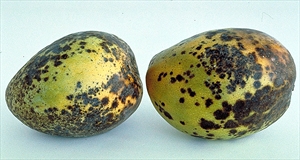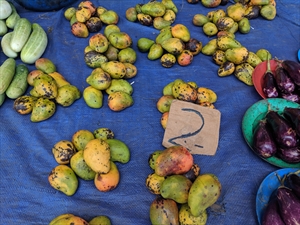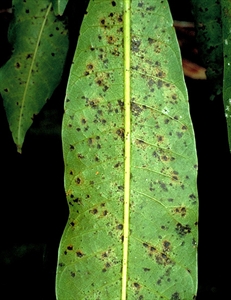Mango anthracnose, mango blossom blight
Pacific Pests, Pathogens, Weeds & Pesticides - Online edition
Pacific Pests, Pathogens, Weeds & Pesticides
Mango anthracnose (009)
Glomerella cingulata (it also has the name of Colletotrichum gloeosporioides). Glomerella is the sexual stage of the fungus, and Colletotrichum the asexual stage. The disease is often referred to as 'anthracnose' of mango. The word anthracnose means 'coal', so fungi that produce dark spots are often given this name. Another fungus also causes leaf spots: Scolecostigmina mangiferae (see Fact Sheet no. 325).
Asia, Africa, North, South and Central America, the Caribbean, Europe, Oceania. Anthracnose of mango has been recorded from Australia, American Samoa, Cook Islands, Federated States of Micronesia, Fiji, Guam, Marshall Islands, New Caledonia, Palau, Papua New Guinea, Samoa, Solomon Islands, Tonga, and Vanuatu.
Mango. Many other crops are hosts of this fungus, including avocado, capsicum, coffee, eggplant, papaya, tomato and yam. There are different strains, infecting different crops and weeds.
Large numbers of spores are formed in the spots; the spores are splashed by rain onto other leaves, flowers and shoots. They germinate, infect and produce more spots and blights. Young leaves are most susceptible to infection (Photo 1). At first, the spots are small, black and irregular, often expanding to form large dead areas that dry and fall out.
On mature fruits, the fungus remains as pinpoint infections until the fruit ripens; then the infections form dark brown to black spots with orange-pink spore masses (Photo 2).
The fungus causes severe damage during wet weather. It causes a blight of flowers and young shoots, leaf spots, and fruit rots. In wet weather, flower blight results in low yield and shoot dieback. Young infected fruits develop black spots, shrivel and fall off. Infection of mature fruit leads to losses in storage.
Stigmina causes black spots on the leaves, which may merge to form large black areas. During wet weather the fungus may cause early leaf fall.
Look for flower blights, and spots on young leaves and fruits in wet weather. However, it is not always easy to distinguish between diseases caused by Glomerella and Stigmina. Spots of Glomerella are usually larger on the leaves, whereas those of Stigmina are about 6 mm diameter, surrounded by a wide light greenish zone (Photos 3-5).
These diseases are serious in high rainfall areas and difficult to control. Management requires pruning of the trees and applications of fungicides.
CULTURAL CONTROL
It is important to prune trees to allow air to flow freely through the tree canopy to reduce humidity. Trees should be less than 4 m tall for easy management and harvesting. Diseased twigs should be removed and burnt along with fallen leaves.
RESISTANT VARIETIES
Indo-Chinese/Philippine varieties are said to have some resistance to the fungus and need to be tested in Pacific island countries. They have good flavour, and flesh with low-fibre.
CHEMICAL CONTROL
Frequent and timely application of chemicals is necessary to control Glomerella leaf and flower blight. Applications need to begin when the flowers first appear and continue at recommended intervals (e.g., 3 to 4-week) until the pre-harvest waiting period. In Australia, several fungicides are registered from the control of anthracnose, including mancozeb, copper (copper hydroxide, copper oxide, copper oxychloride or copper sulphate), prochloraz, or azoxystrobin. See guide to their use: https://www.dpi.nsw.gov.au/__data/assets/pdf_file/0011/125876/mango-anthracnose-pf19.pdf).
Post-harvest dips in fungicide (e.g., carbendazim) and hot water (both treatments are for 5 minutes at 52°C) control fruit infections, preventing storage rots. If using carbendazim, allow 3 litres of dip per kilogram of fruit.
____________________
When using a pesticide, always wear protective clothing and follow the instructions on the product label, such as dosage, timing of application, and pre-harvest interval. Recommendations will vary with the crop and system of cultivation. Expert advice on the most appropriate pesticide to use should always be sought from local agricultural authorities.
AUTHORS Helen Tsatsia & Grahame Jackson
Information from Chin D et al. (2010) Field guide to pests, beneficials, diseases and disorders of mangoes. Northern Territory Government, Department of Resources, Australia. (https://dpir.nt.gov.au/__data/assets/pdf_file/0006/227832/mango_field_guide.pdf); and Stovold GE, Dirou JF (2004). Blight diseases in mangoes. agnote. NSW Department of Primary Industries. (https://www.dpi.nsw.gov.au/__data/assets/pdf_file/0009/120114/blight-disease-mango.pdf). and from Nelson SC (2008) Mango anthracnose (Colletotrichum gloeosporoioides). (Cooperative Extension Service. College of Tropical Agriculture and Human Resources, University of Hawai'i at Manoa. (https://www.ctahr.hawaii.edu/oc/freepubs/pdf/pd-48.pdf). Photos 1-3,5 Kohler F, et al. (1997) Diseases of cultivated crops in Pacific island countries. South Pacific Commission. Pirie Printers Pty Limited, Canberra, Australia. Photo 4 McKenzie E (2013 Scolecostigmina mangiferae PaDIL - (http://www.padil.gov.au).
Produced with support from the Australian Centre for International Agricultural Research under project PC/2010/090: Strengthening integrated crop management research in the Pacific Islands in support of sustainable intensification of high-value crop production, implemented by the University of Queensland and the Secretariat of the Pacific Community.









